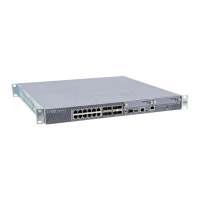•
Two security zones are created: trust and untrust.
•
Interface ge-0/0/0 is in the untrust zone, while interfaces ge-0/0/1 through ge-0/0/3
are in the trust zone.
•
A security policy is created that permits outbound traffic from the trust zone to the
untrust zone.
•
Source Network Address Translation (NAT) is configured on the trust zone.
If the current active configuration fails, you can use the load factory-default command
to revert to the factory-default configuration.
Related
Documentation
Viewing SRX1500 Services Gateway Factory-Default Settings on page 72•
• Accessing J-Web on the SRX1500 Services Gateway on page 77
• Configuring the SRX1500 Services Gateway Using J-Web on page 72
• Accessing the CLI on the SRX1500 Services Gateway on page 77
Viewing SRX1500 Services Gateway Factory-Default Settings
To view the factory-default configuration of the services gateway using the CLI:
1. Log in as the root user and provide your credentials.
2. View the list of default config files:
root@srx1500>file list /etc/config
3. View the required default config file.
root@srx1500> file show /etc/config/<config file name>
Related
Documentation
Understanding SRX1500 Services Gateway Factory-Default Settings on page 71•
• Accessing J-Web on the SRX1500 Services Gateway on page 77
• Configuring the SRX1500 Services Gateway Using J-Web on page 72
• Accessing the CLI on the SRX1500 Services Gateway on page 77
Configuring the SRX1500 Services Gateway Using J-Web
•
Configuring Root Authentication and the ManagementInterface from the CLI on page73
•
Configuring Interfaces, Zones, and Policies with J-Web on page 74
Copyright © 2017, Juniper Networks, Inc.72
SRX1500 Services Gateway Hardware Guide

